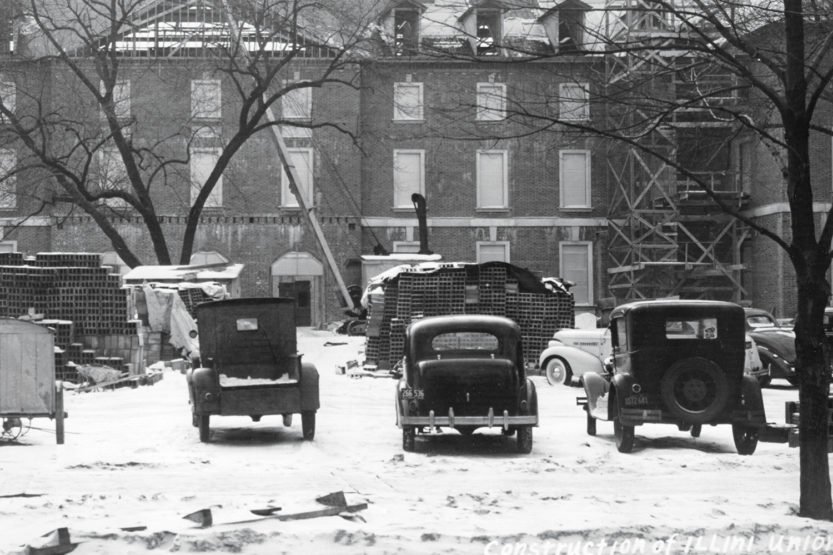A history of cars on campus
 Exceptions to the ban were made for those who were over 25 years old, married or able to demonstrate the need for a car; in 1948, the age limit was lowered to 21, which resulted in an increase in vehicles on campus, such as those pictured in this 1940s photo. (Photo courtesy of University of Illinois Archives)
Exceptions to the ban were made for those who were over 25 years old, married or able to demonstrate the need for a car; in 1948, the age limit was lowered to 21, which resulted in an increase in vehicles on campus, such as those pictured in this 1940s photo. (Photo courtesy of University of Illinois Archives)
William O’Dell, ’31 BUS, belongs to a select group—he is one of the few University of Illinois students to be expelled for driving a car on campus.
In 1930, O’Dell was only a few weeks from graduation when he borrowed the family automobile so he could take his girlfriend to the big spring dance. There was just one problem: Undergraduates at Illinois were not allowed to have cars on campus.
As O’Dell began his trip to the Chicago area to return the vehicle to his parents following the dance, someone spotted him driving down Green Street in Champaign. When he returned to campus by train, a note from Thomas Arkle Clark, dean of men, was waiting for him. Clark asked O’Dell to come to his office the next morning.
Meeting with the dean “would strike terror into anyone’s heart,” O’Dell said in a 2001 interview with Ellen Swain, MS ’95 LIS, of the Student Life and Culture Archives. As two-time Pulitzer Prize winner James Reston, ’32 MEDIA, HON ’62, once wrote, Clark “looked like a saint, but had the mind of a cop.”
Some people even suspected that Clark had spies on campus—O’Dell wondered if this was how the dean knew he had been driving down Green Street. Regardless, during their 40-second meeting, O’Dell was expelled.

From 1926 through the 1950s, undergraduates were not permitted to have cars on the University of Illinois campus, but that didn’t stop some students, such as those shown with a Ford Roadster in this 1936 photo, taken in front of the Kappa Alpha Psi fraternity house. (Photo courtesy of University of Illinois Archives)
Cars were a novelty in the early part of the 20th century, as was the idea of allowing them on campus. In 1927, many educators considered vehicles “a timewaster, a peril to safety and a menace to morals,” according to a publication called The Motorist. That same year, a Daily Illini headline referenced The Insidious Car.
Universities nationwide began to clamp down on campus car usage following grave automobile accidents. Eight students were killed in a wreck at the University of Michigan in the 1920s. Around the same time, one man died and two others were seriously injured in an incident at Illinois, as Fred H. Turner, UI dean of students, stated in a 1947 Daily Illini retrospective. The result was UI’s 1926 ban on cars for undergraduates.
The ban led to a short-lived revival of an older form of horsepower. Stable owners reported that demand for horse-drawn buggies exceeded supply, with “more than 50 calls being received for them in one day at an Urbana stable,” according to The Daily Illini (Oct. 30, 1926).
There were exceptions to the undergraduate auto ban. If you were over the age of 25, married or able to demonstrate the need for a car, you could get a permit. In 1948, the age limit was lowered from 25 to 21, but restrictions remained until the 1950s. By 1954, virtually all undergraduates were allowed to have cars, except for freshmen under the age of 21 and students who were on any sort of probation.
With the loosening of restrictions, more students brought cars to campus, and the cars began to take on a personality of their own.
“Cars are painted every color of the spectrum, from chartreuse to shrimp; fitted up with every known accessory, from spotlights to venetian blinds; tuned-up and polished until they look like new,” according to an Oct. 16, 1956, article in The Daily Illini. “One Chevrolet, about ’41 vintage, is painted pink and yellow in hardtop convertible fashion.”
With more vehicles came the dilemma of where to park them all.
“The parking system on campus is downright pathetic,” stated one student in a 1948 Daily Illini poll.
“I’d love to see some student parking lots, but where would they be located?” griped another. “The faculty members seem to have the choice spots on campus.”
Over the years, the University has addressed this need by adding more street meters and parking lots for both students and staff.
More recently, technology has caught up to transportation needs, with such alternatives as the Zipcar sharing service for those who don’t own vehicles.
Of course, there is always the tried-and-true bicycle, such as the Hercules 10-speed that John Matras, ’70 LAS, recalls riding to and fro. There was just one limitation to the two-wheeled transportation mode: Matras says his bike was “not very good for ‘parking’” when on a date.

